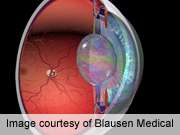In patients with diabetes, with or without diabetic retinopathy, serum apolipoproteins are associated with markers of systemic and retinal microvascular dysfunction, according to a study published in the July issue of Diabetes.
(HealthDay) -- In patients with diabetes, with or without diabetic retinopathy, serum apolipoproteins (apos) are associated with markers of systemic and retinal microvascular dysfunction, according to a study published in the July issue of Diabetes.
Muhammad Bayu Sasongko, M.D., from the University of Melbourne in Australia, and colleagues investigated whether apoAI and apoB levels correlated with measures of systemic and retinal microvascular function in 224 patients with diabetes (85 type 1 and 139 type 2). Serum lipids and lipoproteins from fasting blood; skin responses to sodium nitroprusside (endothelium independent) and acetylcholine (ACh) (endothelium dependent) iontophoresis; flicker-light-induced retinal vasodilatation; and retinal vascular tortuosity were assessed.
The researchers found that every standard deviation (SD) increase in apoAI level correlated significantly with ACh-induced skin perfusion (mean change, 1.27 percent) and flicker-light retinal arteriolar vasodilatation (0.33 percent), while there was an inverse correlation with arteriolar tortuosity (−2.83 × 10−5), after adjustment for age and sex. These associations persisted in multivariable models. For apoB, each SD increase correlated significantly with arteriolar tortuosity only (1.75 × 10−5). Serum apoAI was inversely related to retinal vessel tortuosity and correlated positively with increased vasomotor responsiveness to ACh and flickering light.
"Our findings may elucidate the role of apos in diabetic retinopathy and support previous evidence that serum apos are stronger biomarkers for diabetic retinopathy, and possibly other diabetic microvascular complications, than traditional lipids," the authors write.
Full Text (subscription or payment may be required)
Journal information: Diabetes
Copyright © 2012 HealthDay. All rights reserved.


















